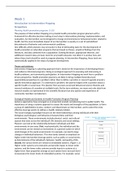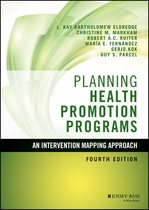Week 1
Introducton to Interventon Mapping
Perspectves
Planning Health promoton programs (1-18)
The purpose of Interventon Mapping is to provide health promoton program planners with a
framework for efectve decision making at each step in interventon planning, implementaton, and
evaluaton. An interventon can be designed to change environmental or behavioral factors related to
health, but the most immediate impact of an interventon is usually on a set of well-defned
determinants of behavior and environmental conditons.
One difculty which planners may encounter is that of delineatng tasks for the development of
health promoton or educaton programs that are based on theory, empirical fndings from the
literature, and data collected from a populaton. xistng literature, appropriate theories, and
additonal research data are basic tools for any health educator, but oten it is unclear how and
where these tools should be used in program planning. In Interventon Mapping, these tools are
systematcally applied in the steps of program development.
Theory and evidence
Interventon Mapping is a planning approach that is based on the importance of developing theory-
and evidence-informed programs, taking an ecological approach to assessing and intervening in
health problems, and community partcipaton. In Interventon Mapping we work from a problem-
driven perspectve. ealth promoton planners are likely to bring multple theoretcal and
experiental perspectves to a problem rather than to defne a practce or research agenda around a
specifc theoretcal approach. To understand a problem, the planner begins with a queston about a
specifc health or social issue. The planner then accesses social and behavioral science theories and
research evidence of causaton at multple levels. By the term evidence, we mean not only data from
research studies as represented in the scientfc literature but also opinion and experience of
community members and planners.
cological Models and Systems in ealth Promoton Program Planning
Systems approaches have emerged as an important analytc and planning tool in public health. The
importance of using a systems approach to assess the needs and strengths of the populaton, to form
a group of stakeholders to plan, conduct, and disseminate an interventon, and to select the most
efectve leverage points to address a health-related problem.
The social ecological paradigm focuses on the interrelatonships among individuals with their
biological, psychological, and behavioral characteristcs and their
environments. These environments include physical, social, and cultural
aspects that exist across the individual’s life domains and social setngs.
Planners can look at the relatonship between individuals and their
environments in two ways. First, mechanistcally, the individual and the
environment can be viewed as mechanisms in a general system in which
small changes in the social environment, for example, can lead to large
changes in individual behaviour. This view tends toward an emphasis on
higher-order interventon leverage points, such as policy or social norms,
as determinants of the individual’s behavior, health, and quality of life.
Second, the various levels are viewed as embedded systems. (Figure 1.1)
igher-order systems set constraints and provide inputs to lower-order
systems, and the lower-order systems provide inputs to systems at a
higher level. New propertes emerge at each system level, but each level
incorporates the lower levels of embedded systems. For example, social
, norms exist independently of the individual even though the individual perceives them. An
interventon may infuence both levels (that is, the actual norms and the individual percepton), and
these may, in turn, infuence both health behavior and health.
A program may be aimed at any ecological level and have efects on that level and all the levels
nested within it.
Agency in the environment
We draw the approach to change at the various ecological levels from three traditons. The frst is
that of Kurt Lewin, who focused on the gatekeepers within channels. The second is social exchange
theory, which focuses on the positons or roles of persons within the social system (Coleman, 1990),
and the third is the MATC model that has been used to plan multlevel interventons for health
educaton Simons-Morton (1988).
Throughout the book, we have adopted the approach of Simons-Morton and colleagues (1988) of
looking at agents (decision makers or role actors) at each systems level: interpersonal (for example,
parents), organizatonal (for example, managers of school food services), community (for example,
newspaper editors), or societal (for example, legislators).
Partcipaton in ealth Promoton Planning
All health promoton program development, adaptaton, implementaton, and evaluaton should be
based on broad partcipaton of community members. quitable community partcipaton helps to
ensure that program focus refects concerns for the local community; can bring a greater breadth of
skills, knowledge, and expertse to the project; can make sure that the research topic comes from, or
refects, a major concern of the local community; and will improve external validity of interventons
and evaluaton by recogniton of the local knowledge of community members.
The need for a framework for Interventon Development – vidence Based Practce
A systematc process of interventon development can also help with documentaton and ultmately
move the health educaton feld toward evidence-based practce. Best practces for interventon are
oten labelled as such based on reviews that emphasize the importance of their internal validity
rather than generalizability. Currently there is considerable push in the health promoton community
for greater external validity in interventon testng—labelled practce-based evidence as a facilitator
of evidence-based practce.
Theory at a Glance (5)
Explanatory theory describes the reasons why a problem exists. It guides the search for factors that
contribute to a problem (e.g., a lack of knowledge, self-efcacy, social support, or resources), and can
be changed. xamples of explanatory theories include the ealth Belief Model, the Theory of
Planned Behavior, and the Precauton Adopton Process Model.
Change theory guides the development of health interventons. It spells out concepts that can be
translated into program messages and strategies, and ofers a basis for program evaluaton. Change
theory helps program planners to be explicit about their assumptons for why a program will work.
xamples of change theories include Community Organizaton and Difusion of Innovatons.





